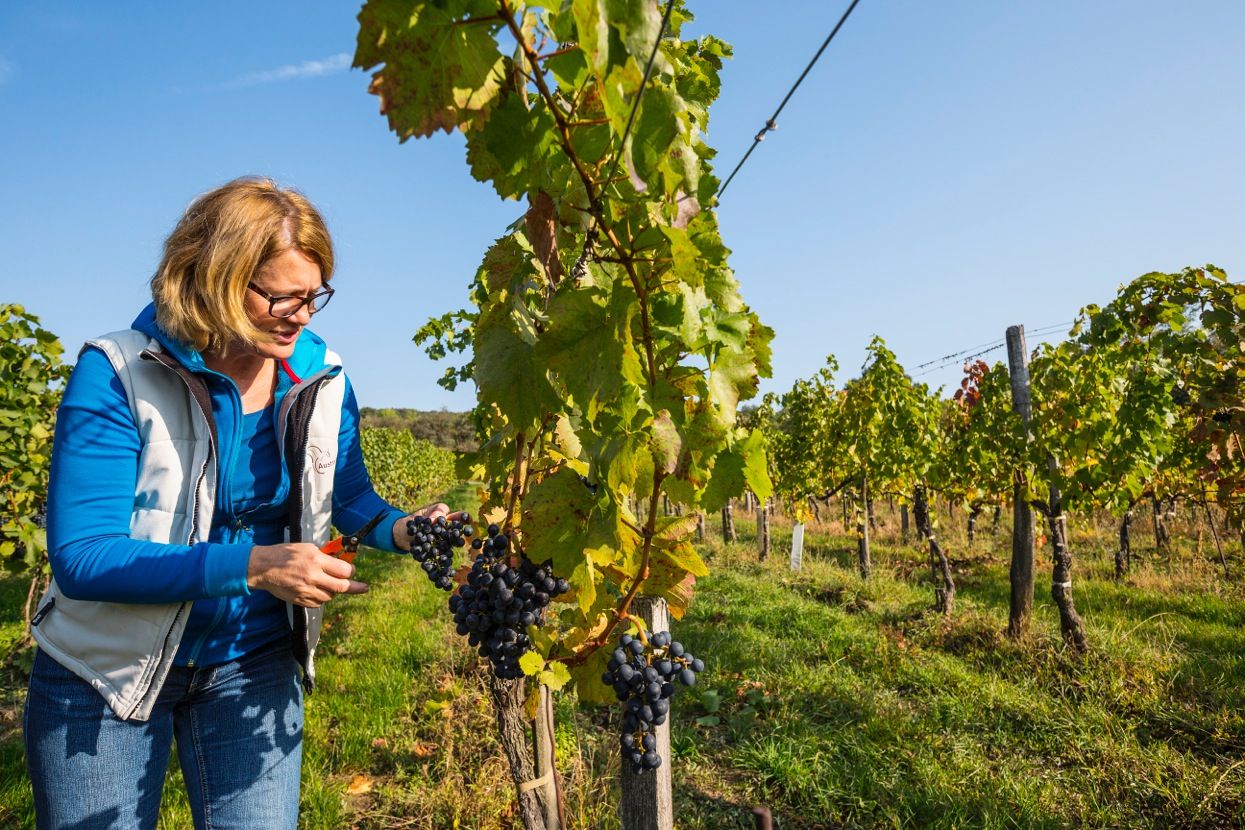Top 10 blaufrankisch wines: Austria’s grape of the moment

Dorli Muhr, here in one of her Spitzerberg vineyards, created two of our Top 10 blaufrankisch wines in this report.
Vibrant yet deep and spicy, concentrated yet light on its feet, good and great Austrian blaufrankisch tastes like no other red wine. That’s a bold statement, but all these new wines have a very distinctive taste of the place where they grew. And even if you ignore that aspect of them, which the French call terroir, they are still excitingly different and very food-friendly reds. No wonder there’s growing international interest in these wines.
Most of the new blaufrankisch come from the state of Burgenland to the south and southeast of Vienna close to the Hungarian border. In fact, this grape variety ignores the border, flourishing on both sides. Climatically it is one region called Pannonia. The grape’s original name is the Hungarian kekfrankos; blaufrankisch is a German translation.
Burgenland was actually part of Hungary until a plebiscite in 1920 when it switched to Austria. So, it is actually an Austro-Hungarian grape variety. Today Austria has 3,009 hectares (7,435 acres) planted making it the second most widely planted red grape, and in Hungary it is the most widely planted grape altogether with 7,260 hectares.
Read more: THE RHEINGAU’S PRINCE HAS COME

Roland Velich of the Moric winery says his job is to get out of the way of the grape's expression of the terroir.
New style blaufrankisch stand out because of their frank fruit (elderberry, wild blackberry, sloe), spice (clove, allspice, juniper) and floral (violets, violets, violets!) aromas from the grape. The oak is either very discreet or completely invisible, the crunchy to silky tannins coming almost exclusively from the grape rather than the cooperage. The grape’s distinctive acidity lifts the wines in the same way point shoes lift a ballerina. In the best wines it also pushes the mineral character into the foreground.
The mineral character of blaufrankisch varies greatly because the grape grows well on limestone and various kinds of slate plus sandy and gravelly soils. “Blaufrankisch is able to translate the soil 100% into wine,” said Dorli Muhr, of the eponymous winery in Prellenkirchen/Carnuntum (Carnuntum isa small region outside Burgenland to the east of Vienna). In her area limestone is the dominant bedrock from which the soils were formed, but even then there are differences between sites. Single-vineyard bottlings are a common policy among top blaufrankisch producers. As Roland Velich of the Moric winery in Grosshoflein/Burgenland said, “We have a great terroir and a wonderful indigenous grape variety. Our job is to make sure nothing gets in the way of their expression.”
Although the growing interest has resulted in prices moving up even the most sought after wine, the Blaufränkisch Burgenland Lutzsmannsburg Alte Reben from Moric can still be found for under $100. We rated the 2017 vintage 98 points. Last year it was our equal highest-rated wine of this category with the Blaufränkisch Burgenland Reihburg R2 2015 from Schiefer in Welgersdorf. Just behind them with 97 points was the Blaufränkisch Canuntum Spitzerberg 2018 from Dorli Muhr. Both the latter wines are in the same price range.
Read more: TOP 100 WINES OF GERMANY 2020

Traditional vineyard houses (cellar below, tasting room above) in the Eisenberg, and some of the slate soils that the blaufrankisch grape enjoys.
It’s very striking how all three of these producers are outsiders. Before Uwe Schiefer became a winemaker in 1990 he was a top sommelier, before Roland Velich founded Moric in 2001 he was a casino croupier and although Dorli Muhr started making wine in 2002 she still runs her winery alongside the Wine + Partners international PR company in Vienna.
Sadly, this situation is not really a sign of Austrian social mobility, as the contrast with dry white Austrian gruner veltliner (the nation’s signature white grape variety) makes clear. Ninety-nine percent of top Austrian gruner veltliners are made by winemakers from families with wine in their genes. Blaufrankisch attracted so many outsiders precisely because 20 plus years ago it was such an under-developed category. Uwe Schiefer’s motto: “Break on through to the other side” (a quote from The Doors) could be applied to all of these pioneers.
There are leading blaufrankisch winemakers with a deep wine background like Gernot Heinrich und Hans Nittnaus in Gols, important producers of Leithaberg blaufrankisch wines, or Christoph Wachter of Wachter-Wiesler in Duetsch-Schutzen in the Eisenberg region. The latter is missing from our blaufrankisch Top 10 only because when we last tasted his wines they were barrel samples. Then his Blaufränkisch Eisenberg Ried Saybritz Reserve 2018 rated 95-96, just ahead of his other 2018 single-vineyard wines.
Read more: IS 2019 GERMANY’S 100-POINT VINTAGE?

Perfectly ripe blaufrankisch grapes ferment (left); Spitzerberg vines bask in the sun.
Climate change is challenging gruner veltliner in some parts of Austria, but blaufrankisch looks to have a great future under the new conditions. “The drier the conditions, finer and more expressive the wines become!” enthuses Dorli Muhr. And getting to know blaufrankisch is not expensive as her Prellenkirchen Samt & Seide 2018, plus Schiefer’s Vom Blauen Schiefer E 2016 and Moric’s regular Blaufränkisch Burgenland 2018 show.
Take a look at our Top 10 blaufrankisch wines below.
- Stuart Pigott, senior editor